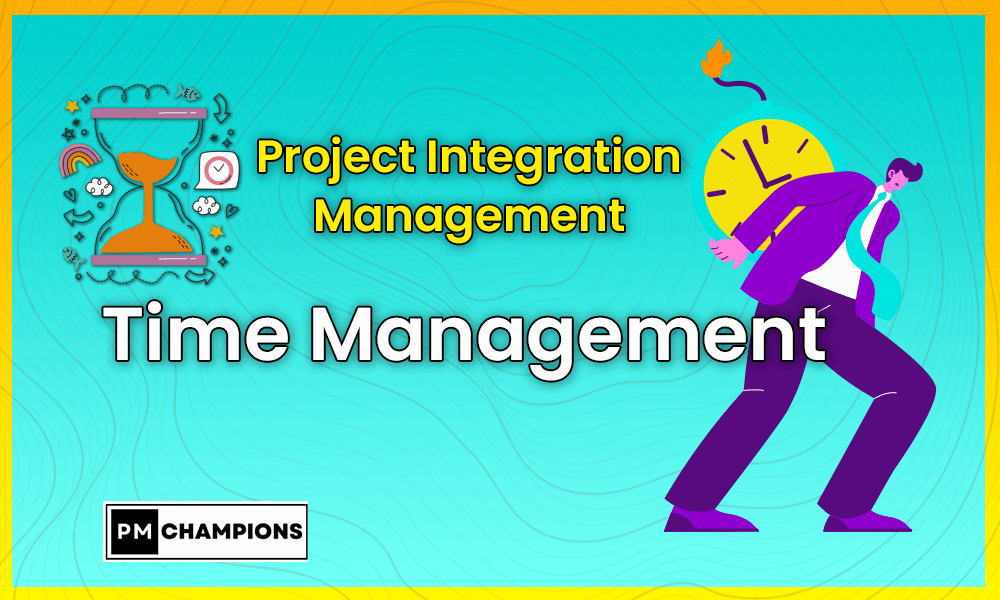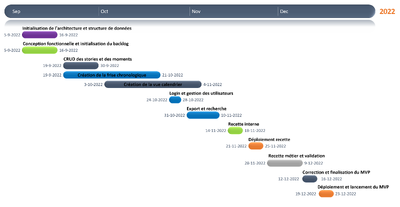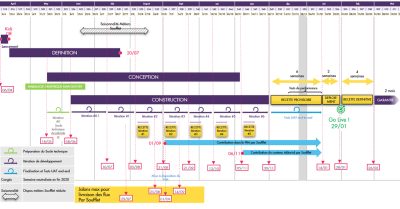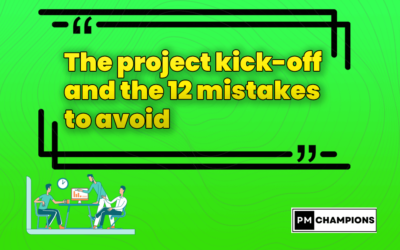
“He who has time and waits for time wastes his time “
William Camden
Time in Project Management
According to the Project Management Institute, time management is one of the six main functions of project management, alongside resource management, cost management, communications, scope, and quality management.
Time management is an essential objective in any project, as evidenced by the famous Quality-Cost-Time triptych, where each element depends on the others and is a crucial issue for the success of the project.

A project is a temporary undertaking to deliver a specific product, service , or outcome , with a set beginning and end.
The project manager’s challenge is to optimize the planned time investment for the work (the costs sold) within the time allocated to the project, in an efficient and relevant way.

Agility:
1. Plan a project
To envision
Before establishing a formal schedule, it is essential to clarify the project team’s intentions, the means to achieve them, and the people responsible for executing them.

The scope of the project provides initial indications in this regard.
Then, the Project Plan completes this information by detailing the tasks to be accomplished, the requirements to be met, the deliverables to be produced, the actors involved with their responsibilities defined according to the RACI matrix, the communication channels to be used according to the governance bodies, as well as the deadlines to be respected.
Break down tasks
The first step in project planning is to break down the project into tasks, also known as a Work Breakdown Structure (WBS).

This approach, initiated in the Pre-Sales phase based on the requirements, must be revised at the start of the project.
Each task represents an action to produce an outcome, and all tasks contribute to the achievement of the project’s objective.
It is essential to adopt appropriate granularity , ensuring that tasks are proportionate.
If necessary, they can be grouped into activities or subdivided into subtasks.
In project management, a task is defined by:
- A precise and measurable goal
- The human resources involved, with or without identified profiles.
- Possibly material or financial resources.
- A workload expressed in Man-Days.
- A defined start and end period.
2. Schedule a project
Architecting
At the end of the planning, the components of the project are identified, but their exact sequence is not defined.

It is crucial to prioritize tasks based on various criteria, such as their prerequisites, their dependencies on other tasks (including those performed by external teams), their possible overlap, their independence, or their synchronization.
Scheduling takes into account time, resource, decision, etc., constraints that affect the execution of the project
Mark out
In addition to tasks, the project is punctuated by milestones, marking key milestones, completions, deliverables to be delivered, or particular events.

Milestones are crucial for assessing project progress and recognizing accomplishments at key moments.
Represent
Tasks and milestones are the essential elements of the project schedule, i.e. the visual representation of the project flow as planned and ordered beforehand, but applied to a schedule.

Generally, the Gantt chart is preferred for this representation, which shows the logical sequence of events on the project and their interdependencies.
The Gantt chart provides a two-way view, mirroring:
- The ordered list of tasks (the WBS), with the expected level of detail per task
- The calendar representation of tasks and their dependencies.

Example of a summary schedule (PowerPoint)

Example of a customer schedule (PowerPoint)

Example of a Gantt chart (Jira)
Zoom #1: Time Constraints
When geographically distributing teams, it is crucial to take into account the holidays in each region.

It is recommended, if the availability of resources is known, to anticipate their planned absences as much as possible.
The schedule should be adjusted according to periods of low activity (such as August or December) or important seasonal events (such as Cyber Week or a technical freeze).
In addition, when travelling far away, it is essential to assess the impact of transport on productivity.

Finally, the Quality Assurance Plan (QAP) must integrate contingency management processes, including notice periods, rapid responses, information obligations, and the associated operational consequences.
Zoom #2: The Critical Path
In any project, certain tasks are essential and determine the total duration of the project.

These tasks, constituting the critical path, are essential to its completion and any change in their duration has a direct impact on the end date of the project.
No delays on the critical path can be compensated, which jeopardizes the scheduled delivery date.
Zoom #3: Agility
Although a project conducted according to the Agilemethodology focuses on the incremental delivery of the product through sprints, it is still subject to schedule constraints, such as the delivery of a Minimum Valuable Product (MVP) by a specific date.

Time management remains essential, even in an Agile context, especially in the context of fixed price contract or limited budget.
3. Oversee a project
A project is a dynamic process that continuously adapts to changing circumstances, as evidenced by the regular updating of the schedule with up-to-date data.
At the micro level: the project manager needs to monitor progress and remaining tasks accurately.
At the macro level: it is crucial to measure the overall progress of the project as well as the way remaining to reach the set goal, taking into account both the calendar deadlines and the workloads required to meet them.

These two aspects are complementary and interdependent.
To effectively supervise the project and its components, the project manager relies on internal governance bodies as well as on various tools at his disposal, such as the workload plan, Timesheets (TS), Activity Reports (AR), Gantt planning with tracking the progress of tasks on specific dates, previous action plans, the remaining tasks, etc.

The major challenge lies in the ability to analyze the past while using relevant factual data to anticipate and plan the future of the project in an effective manner.
“Time is money “
Uncle Scrooge
Any temporal drift in a project, whether it is anticipated or noted late (which should have been the subject of a prior risk identification) constitutes a reason for alarm, both internally and with regard to the client.

First, extending the initial deadline implies maintaining resources mobilized beyond the planned period, thus generating additional burdens and necessary organizational adjustments.
In addition, any increase in workload inevitably comes with additional costs, thus impacting the initial budget.
It is crucial to identify the reasons and responsibilities related to this drift in order to decide on the actions to be taken within the framework of the contractual commitment.
For example, this could require the validation of an amendment to the contract if the responsibility lies with the customer, or on the contrary, the implementation of commercial compensation if the default is strictly the responsibility of the company.
In any case, a managerial decision should be made as soon as possible to deal with the situation.
4. Control the project
Controlling a project involves ensuring:

- Compliance with the Project Plan.
- Control of the schedule, including tasks and milestones.
- Compliance of deliverables by the teams.
- Compliance of indicators, KPIs and SLAs.
- Knowledge and management of external factors.
- Minimal risk identification.
- Maintaining engagement.
The project manager is responsible for providing answers on these points, both internally and externally, during the governance bodies, in particular the Project Committee and the Steering Committee.
A project check-up can be carried out by a Delivery Manager on a scheduled or spontaneous basis.
It covers, among other things, these operational aspects related to time management.
Some Laws to Keep in Mind
Parkinson's Law
The work is spread out in such a way as to occupy the time available for its completion. So there have to be deadlines.
Pareto's Law
80% of the effects (completion of a production) are the result of 20% of the causes (production effort).
Murphy's Law
Don’t hide hazards and underestimate a task: you need to count 5% more time per activity.
Carlson's Law
Continuous work takes less time and energy than when it is done in several stages.
Laborit's Law
Starting with the thankless tasks relieves the stress created by the apprehension of the unknown.
Law of Ecclesiastes
Wasting (unproductive) time can be useful if it saves (productive) time












0 Comments